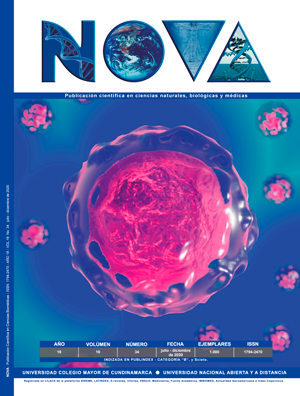NOVA por http://www.unicolmayor.edu.co/publicaciones/index.php/nova se distribuye bajo una licencia Reconocimiento No Comercial- Compartir igual
Así mismo, los autores mantienen sus derechos de propiedad intelectual sobre los artículos,
Declaración de privacidad.
Los nombres y las direcciones de correo electrónico introducidos en esta revista se usarán exclusivamente para los fines establecidos en ella y no se proporcionarán a terceros o para su uso con otros fines.
Revistas Publindex de Ciencias Naturales
Objective: To describe the behavior of Natural Science journals indexed by Publindex in the 2005-2020 period
Methods: Bibliometric Analysis
Publication: 68 journals (88%) of Natural Sciences magazines registered in Publindex
Location: Database Publindex and Google Scholar using Harzing’s Publish or Perish (POP)
Key measures: production indicators (total publications, growth rate and productivity index) and citations (Citas, Index H, Index H5, I10). Inclusion Criterion: Consider all documentary typologies retrieved by Harzing’s Publish or Perish (POP) in a combined journal title and ISSN
Sample: 68 journals (74%) of the Natural Sciences journals registered in Publindex
Setting: Publindex database and academic Google using Harzing Publish or Perish (POP)
Main measurements: production indicators (# publications, publications per year and productivity index), citation (H Index, G Index, E Index, HC Index and H5 Index), informatry (word concurrency, cluster of words with the highest concurrence (30)). In addition, in Inclusion criteria: relation to Publindex, journals were identified by area of knowledge, by publishing institution, categorization by year and perspective from phase 3 for the next measurement.
All the journals registered in the Publindex database in the Great Natural Sciences area and the documentary typologies recovered by Harzing’s Publish or Peris (POP) were considered in a combined search of the journal title and ISSN.
Results: In the national bibliographic index (IBN) there are 68 journals in Natural Sciences, the highest concentration is in the area of Earth and Environmental Sciences knowledge (24%) and Biological Sciences (21%). A total of 50 journals were analyzed, corresponding to 74%, 18 (26%) were excluded as they were not representative for the study. Between 2004 and 2014, an annual average of 54 journals categorized in the IBN was registered, with the new classification model the average being below 19 per year between 2017-2020. 17,197 publications in Google Scholar were identified and 10.5% were purged for duplication. The journals that concentrate the largest number of publications in the overall total are the Colombian Physics Magazine (6.5%), the Colombian Biological Act (6.3%), the Colombian Journal of Entomology (6.2%), the Academy Magazine Colombian of Exact, Physical and Natural Sciences (6.1%) and Caldasia (6%) with more than 900 publications. A total of 58,716 citations and an annual average of 757 citations of publications are recorded. The computerized analysis identified “Colombian Caribbean” as the word with the most concurrence in the publications. The magazines with the highest h index are Caldasia (H = 43), Journal of the Colombian Academy of Exact, Physical and Natural Sciences (H = 37) and Colombian Biota (34). After the simulation for the results of the Publindex 2020 Call in phase 3, the categories that register an increase are A1 of (9%) and C (14%).
Conclusions: 37% of the journals in Natural Sciences have a high possibility of being categorized in the IBN 2020. There has been a decrease in the number of journal publications and citations since 2017 and 2018, respectively. The NOVA journals, Acta Biológica Colombiana, Biota Colombiana, Revista Lasallista de Investigación, Revista de la Academia Colombiana de Ciencias Exacta, Físicas y Naturales y Caldasia have the highest bibliometric indexes (H, G, HC, D), and are also categorized and they plan to follow it in 2020.









